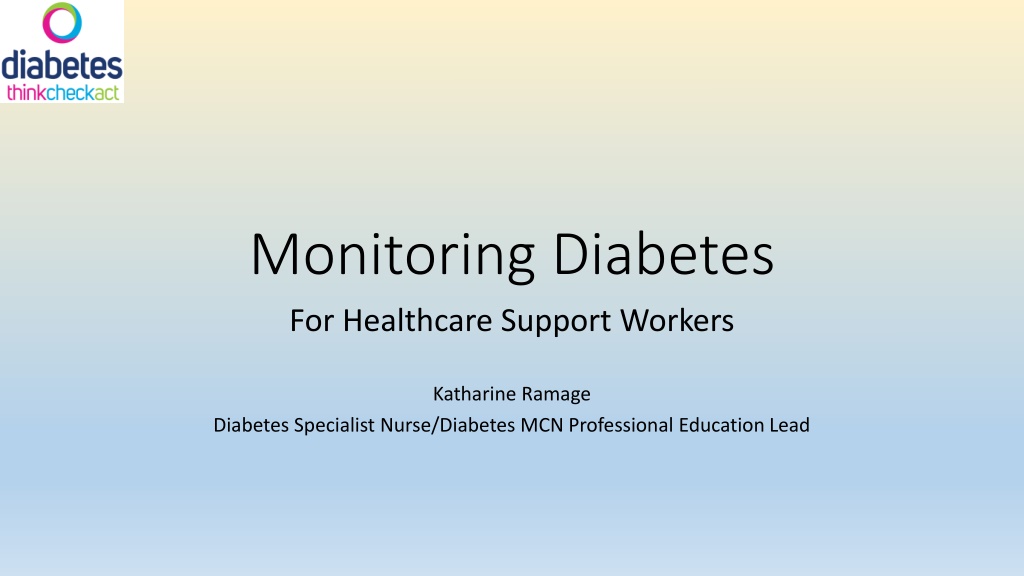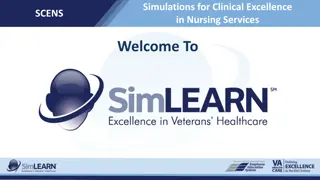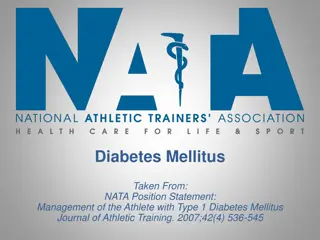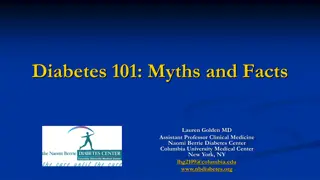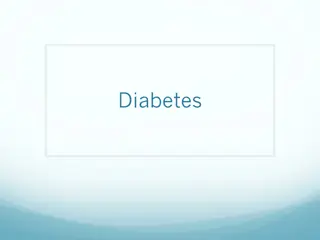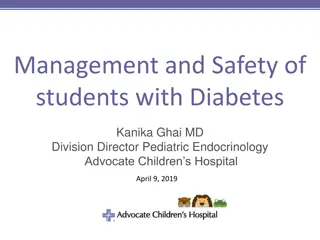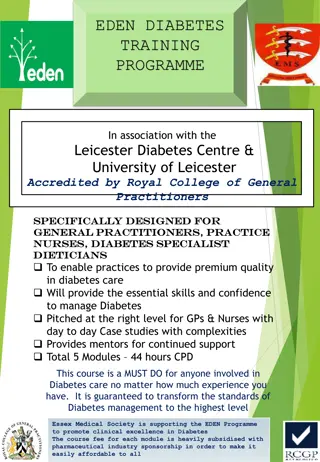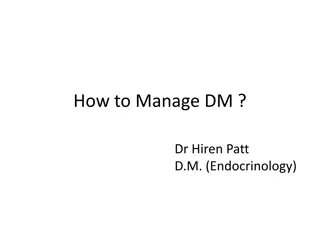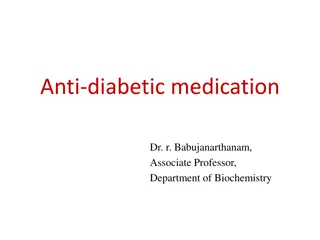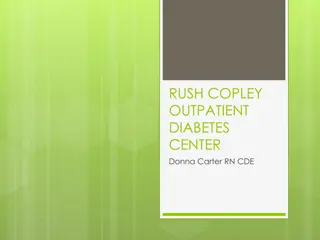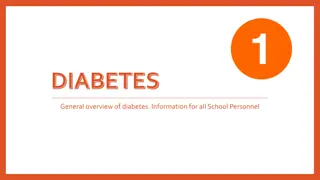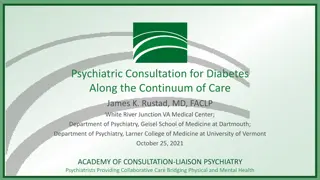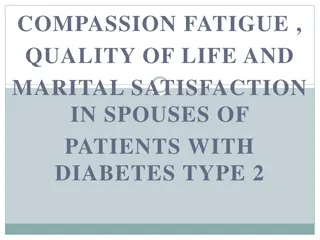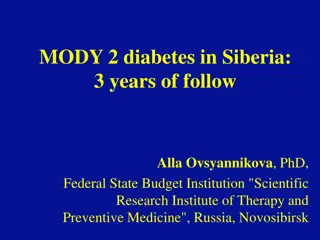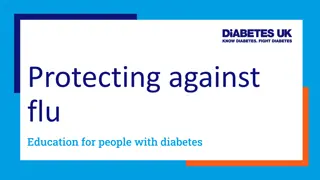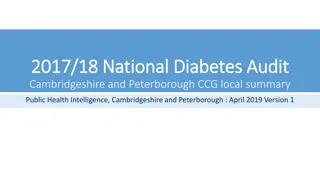Managing Diabetes: Importance, Recognition, and Treatment of Hypoglycemia
Proper management of diabetes is crucial to prevent complications such as physical disabilities, infections, and hospital admissions. Recognizing and treating hypoglycemia, a common side effect of diabetes medications, is essential to avoid serious consequences. Risk factors, signs, symptoms, and possible causes of hypoglycemia should be understood for timely intervention. An algorithm guides healthcare workers in the treatment of hypoglycemia in diabetic patients, emphasizing the importance of quick-acting carbohydrates and glucose monitoring.
- Diabetes management
- Hypoglycemia recognition
- Healthcare support
- Diabetes complications
- Treatment algorithm
Download Presentation

Please find below an Image/Link to download the presentation.
The content on the website is provided AS IS for your information and personal use only. It may not be sold, licensed, or shared on other websites without obtaining consent from the author. Download presentation by click this link. If you encounter any issues during the download, it is possible that the publisher has removed the file from their server.
E N D
Presentation Transcript
Monitoring Diabetes For Healthcare Support Workers Katharine Ramage Diabetes Specialist Nurse/Diabetes MCN Professional Education Lead
Why is it important to manage well? People with diabetes have: Higher levels of physical and cognitive disability Increased risk of pressure sore development Increased rates of hospital admission Increased susceptibility to infection High rates of complications
Recognising Hypoglycaemia Low blood glucose (below 4mmol/L) The most common side effect of insulin and certain oral medications for diabetes Must be excluded in a person with diabetes who becomes acutely unwell, drowsy, unconscious, unable to cooperate, aggressive
Risk Factors No or inadequate blood glucose monitoring Cognitive Increasing age impairment/dementia Reduced carbohydrate intake for any reason Previous severe hypoglycaemia Impaired awareness
Signs and symptoms Trembling/shaking Confusion Dizziness Sweating Poor co- ordination Aggressive behaviour Drowsiness Irritability Poor Loss of communication consciousness
Possible causes Incorrect or inappropriate insulin or oral medication doses Missed or delayed meals Less carbohydrate than normal Failure to monitor blood glucose adequately Vomiting
Algorithm for the Treatment and Management of Hypoglycaemia in Adults with Diabetes Mellitus in Hospital Mild Moderate Severe Patient conscious and able to swallow, but confused, disorientated or aggressive Patient conscious, orientated and able to swallow Patient unconscious/fitting or very aggressive or nil by mouth (NBM) Give 15-20 g of quick acting carbohydrate Glucose drink (eg original Lucozade) 90- 120mls Pure fruit juice 150-200mls 5-7 Dextrosol tablets (or 4-5 Glucotabs) Test blood glucose level after 15 minutes. If still less than 4 mmol/L repeat up to 3 times If this has been repeated 3 times, consider IV 10% glucose at 100 ml/hr or 1mg Glucagon IM* Check ABC, Stop any IV insulin, fast bleep a doctor If capable and cooperative, give 15-20 g of quick acting carbohydrate as for mild hypoglycaemia If patient suitable for IM Glucagon (i.e. no repeated hypos, patient not starved/NBM and no severe hepatic disease) give 1 mg Glucagon IM*. If not capable and cooperative but able to swallow give either 1.5-2 tubes of GlucoGel or give 1mg Glucagon IM*. Test blood glucose level after 15 minutes. If not suitable for IM glucagon, give IV glucose (75 ml 20% glucose or 150ml 10% glucose over 12 minutes, or equivalent) If still less than 4 mmol/L give 15-20 g quick acting carbohydrate. Continue to test every 15mins and repeat up to 3 times if still less than 4mmol/L f this has been repeated 3 times, consider IV 10% glucose at 100 ml/hr. Repeat up to 3 times if necessary Recheck glucose level after 15 minutes -it should now be above 4mmol/L. Follow up treatment as described on the left. If NBM give 10% glucose infusion at 100ml/hr until no longer NBM or reviewed by doctor Blood glucose level should now be above 4mmol/l. Give 20g of long acting carbohydrate eg 2 biscuits or a slice of bread or next meal if due. If IM Glucagon has been used give 40g of long acting carbohydrate in order to replenish glycogen stores. For enteral feeding patients ONLY Restart feed or give bolus feed as per guideline or IV 10%glucose at 100ml/hr See section E of the hypoglycaemia guideline DO NOT OMIT SUBSQUENT DOSES OF INSULIN, CONTINUE REGULAR CAPILLARY BLOOD GLUCOSE MONITORING FOR 24 TO 48 HOURS AND GIVE HYPOGLYCAEMIA EDUCATION OR REFER TO DISN FOR ADVICE *NOTE GLUCAGON MAY TAKE UP TO 15 MINUTES TO WORK, AND MAY BE INEFFECTIVE IN PATIENTS WITH SEVERE LIVER DISEASE OR WHO ARE UNDERNOURISHED. GLUCAGON SHOULD NOT BE USED WHERE ORAL HYPOGLYCAEMIC AGENTS HAVE CAUSED HYPOGLYCAEMIA.
Treatment Once hypoglycaemia is identified, the treatment should be given without delay Quick-acting carbohydrate required to return the glucose level to normal ie: glucose tablets, glucose drink, jelly babies Follow up with more complex carbohydrate snack ie: toast, small sandwich, biscuits - or next meal if due Treatment options will depend on whether patient can swallow, is drowsy/confused or unconscious
Prevention Consider what caused the Hypo Ensure blood glucose level is checked 15 mins after treatment to evidence recovery If BGL remains below 4mmol/l, further fast acting glucose required Medications should be reviewed and adjusted if necessary After initial treatment, follow up with 20g complex carbohydrate snack if patient can safely swallow Consider IV glucose infusion for patients unable to swallow or NBM
Hyperglycaemia Excess glucose in the blood (over 12mmol/L) - If persistent can cause unpleasant symptoms and long-term consequences Many possible causes Possible life-threatening complications: - Diabetic Ketoacidosis (DKA) - Hyperosmolar Hyperglycaemic State (HHS)
Possible causes Dietary factors Sugary drinks, extra snacking, large amount of carbohydrate Illness (eg: infection) Stress Insufficient treatment Problems with insulin (eg: inappropriate storage) Certain medications (eg: steroids) Injection site issues
Blood glucose monitoring Blood glucose monitoring is a priority in patients with diabetes Frequency will vary depending on individual if in doubt, 4 x daily Must be done before food and insulin/oral meds If blood glucose not checked at right time, this will have negative impact on treatment and management Regular monitoring important for early identification of low glucose or hyperglycaemia http://intranet.lothian.scot.nhs.uk/Directory/Diabetes/DiabInfoforHeal thProf/Pages/ProfessionalEducation.aspx
Ward meters data sent to COBAS IT system and stored Complete documentation of results including patient and operator identification Data automatically captured as outcome measures on the Diabetes Dashboard (Tableau) Vital that correct operator ID and patient ID recorded for data to be usable Role in QI
Self Management Self monitoring blood glucose should be encouraged if able Different meters there are a wide range of blood glucose meters in use Libre becoming more common, particularly T1 patients CGMS(Continuous Glucose Monitoring system) Not widely used, but worth being aware of. CSII Continuous Subcutaneous Insulin Infusion(Insulin pump therapy) Important to support patient with self-care where possible Notice any factors that may interfere with patients ability to self care and report
CSII Insulin Pump Therapy Continuous subcutaneous insulin infusion. Quick-acting insulin ie: Novorapid, Humalog, Fiasp Used by 10-15% T1 s in Lothian
What is Libre Sensor measures interstitial glucose
What is Libre measuring? Glucose in the fluid under the skin
Libre is not measuring blood glucose There is a lag between blood and Libre glucose
Insulin Management Insulin must be given at the right time, every time Background insulin i.e: lantus, insulatard, does not need to be given with food, but at same time each day Mixed insulin i.e:Humulin M3, may be once or twice daily, 15-30 minutes before food Quick acting insulin i.e: Novorapid, should be given up to 15 mins before food. Can be used to correct high blood glucose levels.
Oral Medications Common antidiabetes medications Metformin reduces the amount of sugar the liver releases into the blood and increases insulin sensitivity. Gliclazide/Glipazide stimulates the release of insulin from the pancreas Sitagliptin increases the levels of GLP-1 which naturally lowers blood glucose levels Empaglaflozin reduces glucose reabsorption in the kidneys so more glucose is excreted in urine
Injectable Medication GLP-1 Glucagon-like peptide-1 receptor agonists ie: dulaglutide, semaglutide, liraglutide People with Type 2 diabetes may be prescribed a daily or weekly GLP- 1 if existing treatment fails to achieve adequate glycaemic control GLP-1 is a potent incretin hormone which increases insulin secretion, suppresses glucagon secretion and slows gastric emptying The first oral GLP-1, Rybelsus (Semaglutide), was approved in 2020 and is now available on prescription
Considerations Steroid treatment Poor/reduced appetite Fasting/NBM Dietary supplements Enteral feeding Nausea/Vomiting
Not to be ignored If the patient is unwell and you are concerned, seek medical advice Inability to swallow/not able to keep fluids down Vomiting Persistent Diarrhoea Persistently high glucose Underlying infection
Referral to Diabetes Refer at earliest opportunity Possible reasons to refer include: Type 1 diabetes Hypoglycaemia Erratic BGLs Medications stopped or unable to take Advice required on changing/titrating medication Patient requires education; HBGM, Insulin admin Persistent hyperglycaemia Diabetes equipment /supplies required Patient is acutely unwell DKA/HHS Foot ulcers/wounds
Who to refer to This will depend on where you work Community/Nursing Home: Acute: GP Inpatient Diabetes Specialist Nurse - WGH bleep 8687 - RIE bleep 5955 - SJH 3008 District Nurse Community Diabetes Specialist Nurse Diabetes Dr on Call - Contact via Switchboard Podiatrist (Domiciliary or Diabetes Specialist) Podiatrist (Diabetes Specialist)
